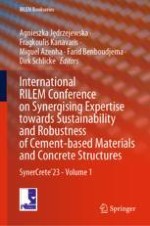2023 | OriginalPaper | Chapter
Use of Recycled Carbon Fibres in Textile Reinforced Concrete for the Construction Industry
Authors : Vanessa Overhage, Thomas Gries
Publisher: Springer Nature Switzerland
Activate our intelligent search to find suitable subject content or patents.
Select sections of text to find matching patents with Artificial Intelligence. powered by
Select sections of text to find additional relevant content using AI-assisted search. powered by
